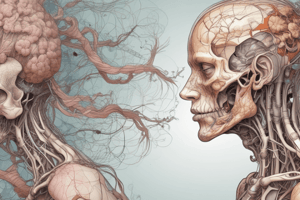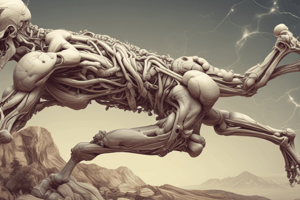Podcast
Questions and Answers
What does Anatomy primarily investigate?
What does Anatomy primarily investigate?
- The functions of different organ systems
- The body's responses to environmental changes
- The structure of the body (correct)
- The chemical processes of the body
Which level of structural organization is characterized by atoms and molecules?
Which level of structural organization is characterized by atoms and molecules?
- Chemical (correct)
- Cellular
- Tissues
- Organs
Which type of anatomy examines specific body regions and is often emphasized in medical education?
Which type of anatomy examines specific body regions and is often emphasized in medical education?
- Surface Anatomy
- Functional Anatomy
- Systemic Anatomy
- Regional Anatomy (correct)
What does Systemic Physiology study?
What does Systemic Physiology study?
Which of the following best describes Tissues?
Which of the following best describes Tissues?
What is the primary focus of Cellular Physiology?
What is the primary focus of Cellular Physiology?
What is the purpose of negative feedback in homeostatic regulation?
What is the purpose of negative feedback in homeostatic regulation?
Which component of the feedback mechanism is responsible for detecting changes in the variable?
Which component of the feedback mechanism is responsible for detecting changes in the variable?
Which characteristic of life involves changes in cell structure and function from generalized to specialized?
Which characteristic of life involves changes in cell structure and function from generalized to specialized?
What is typically NOT a characteristic of positive feedback mechanisms?
What is typically NOT a characteristic of positive feedback mechanisms?
Which of the following best defines metabolism?
Which of the following best defines metabolism?
Under what condition can the set point for a variable be temporarily adjusted?
Under what condition can the set point for a variable be temporarily adjusted?
Which variable is NOT commonly monitored in the context of homeostasis?
Which variable is NOT commonly monitored in the context of homeostasis?
Which of these statements about homeostasis is correct?
Which of these statements about homeostasis is correct?
Flashcards are hidden until you start studying
Study Notes
Anatomy and Physiology
- Anatomy investigates body structure and derives from the term meaning "to dissect."
- Physiology focuses on processes and functions, specifically human physiology which studies the human organism.
Types of Physiology
- Systemic Physiology examines body organ systems.
- Cellular Physiology studies body cells.
Importance of Anatomy and Physiology
- Essential for understanding body responses to stimuli, environmental changes, diseases, and injury.
Types of Anatomy
- Systemic Anatomy studies organ systems.
- Regional Anatomy focuses on specific body regions, often used in medical schools.
- Surface Anatomy examines external features like bone projections.
- Anatomical imaging utilizes technologies (e.g., x-rays, ultrasounds, MRIs) for non-invasive exploration.
Structural and Functional Organization
- Six levels of organization from simplest to complex:
- Chemical: Includes atoms, chemical bonds, and molecules—smallest unit.
- Cellular: Basic life units comprising compartments and organelles (e.g., mitochondria).
- Tissues: Groups of similar cells; four types include epithelial, connective, muscular, and nervous.
- Organs: Combinations of two or more tissue types working together (e.g., stomach, heart).
- Organ-System: Groups of organs contributing to specific functions (e.g., digestive system).
- Organism: All organ systems functioning together, including associated microorganisms like gut bacteria.
Characteristics of Life
- Organization: Functional interrelationships among parts.
- Metabolism: Collective chemical and physical changes that sustain life, involving energy acquisition and utilization.
- Responsiveness: Organisms’ ability to sense and react to environmental changes.
- Growth: Increase in size at both cellular and overall organism levels.
- Development: Changes in form and function through differentiation from generalized to specialized states.
- Reproduction: Production of new cells/individuals and tissue repair.
- Homeostasis: Maintenance of a stable internal environment despite external fluctuations.
Homeostatic Variables
- Examples include body temperature, heart rate, blood pressure, blood glucose, blood cell counts, and respiratory rate.
- Normal range indicates variability around a set point, which is the average value over time (e.g., body temperature fluctuates around this point).
- Set points can be temporarily adjusted based on body activities (e.g., increased body temperature during fever).
Feedback Mechanisms
- Negative feedback: Main mechanism of homeostatic regulation that detects deviation from set points and corrects toward normal ranges.
- Components of feedback include:
- Receptor: Detects changes in a variable.
- Control center: Establishes set point and directs signals to the effector.
- Effector: Causes changes to correct deviations.
- Components of feedback include:
- Positive feedback: Amplifies initial stimulus, leading to further deviations from set points; not typically involved in homeostasis.
- Occurs in normal conditions such as childbirth and can also relate to injury and disease situations requiring negative feedback for correction.
Studying That Suits You
Use AI to generate personalized quizzes and flashcards to suit your learning preferences.





